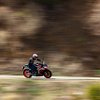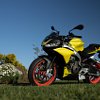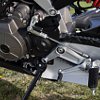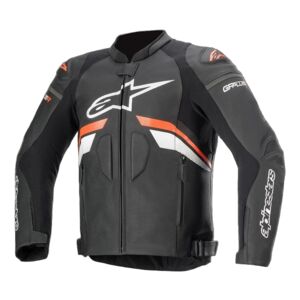Well, it happened again. The best version of a motorcycle is the comfortable one. Aprilia’s 2021 Tuono 660 is a similar slice of metal to its fraternal twin, the RS 660, which Ari reviewed recently. And even though the changes seem small, the upshot is a fairly different experience out on the road.
Fun fact, “Tuono” is Italian for “wide, flat handlebar” [Editor's note: No, it's not.] and that’s exactly where the tweaks to the spec sheet start, a prominent handlebar replacing the sporty, faux clip-ons on the RS 660. Then there’s the obvious update in styling. I would say Aprilia removed the fairing, but our eyes do not deceive us, it’s got an awful lot of clothes on for a naked bike. There are a few invisible chassis changes, namely a steeper steering-head angle and a reduction of triple-clamp offset. Those adjustments make for a shorter wheelbase, all of which is meant to make the bike even more agile than its sibling.

On the electronics front, the two big moves from the RS platform are the inertial measurement unit (IMU) and the quickshifter, neither of which are standard equipment on the Tuono. The only differences beyond that are more nuanced. For example, the Tuono fork is adjustable for spring preload and rebound damping, same as the RS 660, but rebound is controlled only in the right fork leg instead of both as on the RS. Aprilia also learned a little lesson with riders’ boots scuffing the silver paint on the swingarm of the RS 660 (which Ari noted in his article), and so the Tuono comes with plastic guards in place. All of this is to say, the bikes are pretty similar, and that’s before you learn that the quickshifter and IMU can be bolted onto the Tuono for a small fee. More on that later.

I know Aprilia’s public relations department won’t like me suggesting the bikes are so similar, because the idea is for the two machines to occupy different, albeit tangential, segments of the market. But it seemed like the easiest way to get the point across, plus Ari’s article already has all the nitty gritty on how many ride modes it has and why owners will need to run premium gas. To be fair to the PR folks, after a day blasting around coastal California I have to admit the bikes do feel more different than the numbers suggest.
Rolling thunder
The handlebar is the most obvious and noticeable change, and what’s odd is that my perception of the seat and footpegs changed, too. There's a little bit of confusion over whether or not the pegs did move, but most of the parts are identical, and any change seems like it would be almost too small to measure. Despite the RS being an unusually reasonable sport bike ergonomically, the Tuono is a lot more comfortable and it’s perceptible before you even turn the key. One of the many things that didn’t change is the 659 cc parallel twin, which jumps to life with the same startled bark as the company’s big V4 models. I’m not sure if it was intentional but I love it, and even though it’s muted it makes a nice, medium-sized rumble.

Rolling down the road I was immediately struck by how light the Tuono 660 feels. At 403 pounds, the claimed weight is allegedly a pound lighter than the RS 660 and significantly lighter than just about any other full-size street bike. Hell, even the famously simple and compact Yamaha MT-07 is heavier. For what it’s worth, as part of my test ride on the RS 660 a few weeks ago I put it on our scales with a full tank and it rang in at 401 pounds, which suggests the Tuono will be in the same neighborhood. That’s an impressive number, and the Tuono no doubt feels especially agile because of the wide handlebar and extra-pointy geometry that offer more leverage on the fork and front wheel.

After a short stint trotting down Pacific Coast Highway and confirming that the cruise control is still excellent (it is), it was off into the seemingly endless ribbons of pavement laid into the hills in and around Malibu. All of the things that Ari praised about the RS 660’s handling are true for the Tuono as well, except that I think it’s better. Mostly because it’s comfy. It’s not discernibly more precise or balanced, it’s just more reasonable and that big, Tuono ‘bar made me feel even more in command. It’s linear and balanced, light to the touch, with hugely powerful brakes and good chassis feel in the middle of a corner. I’m sure I didn’t set any records, but I went as fast as any decent citizen should on a public stretch of twisty road and never once did I wish the riding position was more aggressive.

About 100 horsepower has long been a sweet spot for street bikes, in my opinion — enough punch to pull a second- or third-gear wheelie without feeling like overkill. Aprilia’s 660 twin is a small engine to claim that much power, and as a matter of course it’s in a pretty high state of tune (premium gas, kids). To access the most exciting noises and feelings of this engine it’s got to be spinning at least 7,000 rpm. There’s good news between idle and about 5,000 rpm, too, where the engine is surprisingly burly. The bad news is that there’s a bit of a hole in the middle there, where the mill loses some motivation and I had to wait a beat or two for it to come alive again.

If I were making excuses for Aprilia, I’d say this is the price of doing business in an era where manufacturers have to jump through all sorts of hoops for exhaust and noise emissions. Not to mention it makes 30 more horsepower than anything else its size, on account of spinning higher to get maximum thrust. Honda’s $30,000 CBR1000RR-R, with another relatively high-revving and high-performing engine, has the same weird void in the midrange. I’m disappointed, but it doesn’t ruin the Tuono experience, it just changes the outlook and expectations you have when you open the throttle.

There are loads of other things this bike delivers on account of being high performance that are good. Like the low weight, vicious brakes, five ride modes, a taut chassis, and the option for an electronics package that will make a GSX-R1000 blush. The final word from Aprilia is that the American team is learning in real time, and it's possible that showroom bikes will have an update to try to fix the flat spot in torque.

How does it compare to everything else?
If you’ve had enough with comparisons to sport bikes, that’s fair. It’s arguably more important to chew over how this Tuono 660 stacks up to similar naked bikes from Japan and Europe. It falls into an odd middle ground among middleweights, having an engine about the same size as a Kawasaki Z650, Suzuki SV650, or the MT-07 but with similar horsepower, technology, features to bikes like Ducati’s Monster 821, KTM’s 790/890 Duke, or Triumph’s Street Triple R. I’m not going to pretend to do a full comparison test here, but in general the Tuono 660 feels taut and fast next to the more utilitarian Japanese bikes. Less playful and a little more purposeful. It’s lighter and higher strung than those few European bikes I mentioned, in a way that suits a new breed of rider — one interested in the sharpest knife, not the biggest.

The Tuono’s MSRP has been set at $10,499, which puts it a few grand above the average price of those three I mentioned from Japan and a little under the average of the Euro trio. Aside from the Street Triple R, arguably the closest comparison to the Tuono’s spec sheet would be Yamaha’s MT-09; a little cheaper and a bit heavier, with similar overall capability, albeit with more of an urban-assault vibe than outright performance. To match the MT-09’s spec pretty exactly (as well as the RS 660), an IMU and the quickshifter can be added to the Tuono 660 independently for $199 each.
To be or not to #bearacer
This is the part of the program where I typically rant and rave about all of the little things and you think I’m being too picky or not picky enough. This Tuono just about has me stumped. I’m inclined to complain about the plethora of ride modes and how there’s no real use for “Challenge” or “Time Attack” but that’s kind of like whining about too many types of bread served before dinner. If you don’t want them, ignore them. I do really like all of the adjustability in the “Individual” mode. Being able to turn ABS intervention off on the rear wheel but maintain whatever amount of traction control you prefer and choose throttle response is neat, and appropriate for this machine.

I was ready to moan about too little steering sweep until I did a day of U-turns for photos and never had a problem with it. The rebound damping on the shock was incredibly loose, and unfortunately the adjuster was buried under enough plastic that I didn’t have time to play with it on the ride. Here again, it seemed like something was out of whack but on the road I thought the chassis felt quite good. The only real disappointment is that hole that the engine falls into right in the heart of the midrange. Frustrating as it is, the bike pays it back pretty well later in the revs.
At the end of the day if you’re not excited about this bike, check your pulse. It’s exciting to ride, flashy to look at, and has somehow managed to make a little nest for itself in the market. If you already bought an RS 660, hopefully it has track bodywork on it by now.
|
2021 Aprilia Tuono 660 |
|
|---|---|
| Price (MSRP) | $10,499 |
| Engine | 659 cc, liquid-cooled, eight-valve, parallel twin |
|
Transmission, final drive |
Six-speed, chain |
| Claimed horsepower | 100.0 @ 10,500 rpm |
| Claimed torque | 49.0 foot-pounds @ 8,500 rpm |
| Frame | Aluminum twin-spar |
| Front suspension | KYB 41 mm fork adjustable for spring preload and rebound damping; 4.7 inches of travel |
| Rear suspension | KYB shock adjustable for spring preload and rebound damping; 5.1 inches of travel |
| Front brake | Brembo four-piston calipers, 320 mm discs with ABS |
| Rear brake | Brembo two-piston caliper, 220 mm disc with ABS |
| Rake, trail | 24.1 degrees, 4.1 inches |
| Wheelbase | 53.9 inches |
| Seat height | 32.2 inches |
| Fuel capacity | 3.9 gallons |
| Tires | Pirelli Diablo Rosso Corsa II, 120/70R-17 front, 180/55R-17 rear |
| Claimed weight | 403 pounds |
| Available | April 2021 |
| Warranty | 24 months, unlimited miles |
| More info | aprilia.com |



















